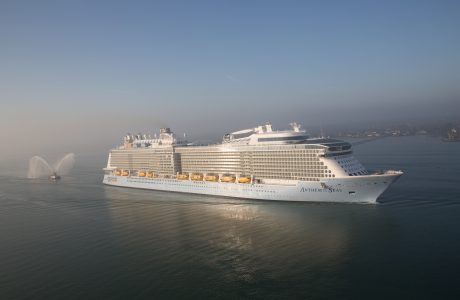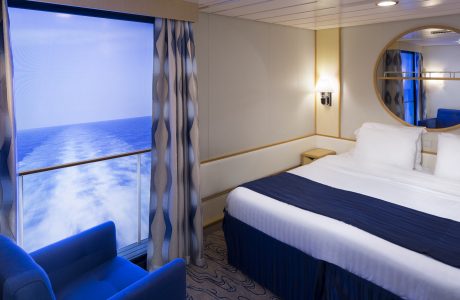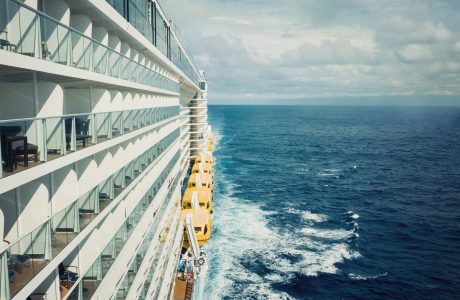Swedish 1st Officer Lovisa Forssberg didn’t always know she wanted to work on cruise ships. But when the idea struck her at the age of 19, she hit the high seas and never turned back, despite the challenges that come with navigating an industry consisting mainly of men.
After nearly 10 years of sailing, from the shores of Singapore to the glacier-filled waters of Alaska, Lovisa has made her way through the ranks to 1st Officer–which means she is part of the captain’s team that is on the bridge of a Royal Caribbean ship.
We caught up with her for insight into her maritime career, any advice she could share, and the goals she has her eye on, not only for personal growth but to help the industry thrive.

Lovisa Forssberg has been sailing for almost 10 years and spent a chunk of her time on Liberty of the Seas.
Credit: Royal Caribbean
Q: What drew you to the maritime industry?
Lovisa: When I was 19 and trying to decide on a career, I had a lot of options to choose from. Eventually, I went with the maritime industry because I asked myself, “What will make me happy?” Who doesn’t want to sail around the world for a living? Throughout school, I sometimes wondered if it was really the right choice for me, and it wasn’t until I came to a cruise ship that I felt like I’d found my path. I love that there is always great energy and an ongoing focus on safety awareness.
Q: How have you navigated an industry consisting mainly of men, and what advice would you give to young women following in your footsteps?
Lovisa: When I started as a cadet on cargo ships, I faced sexism, and from time to time, I felt unsafe. I made the decision to work for Royal Caribbean and continue to do so because of its culture and energy but also because I’ve never experienced anything like what I did on cargo ships. It’s also important to me that the company I’m with is actively working toward equality. And if I have concerns about any matter, I feel they are taken seriously.
To other young women, speak your mind and trust yourself. Don’t let anyone intimidate you with old views that “women need to be like this, or women need to do that.” Also, company culture and coworkers are among the most important things. In my experience, if you have a healthy culture and good colleagues, the rest will usually be manageable.
Q: How did you become 1st Officer?
Lovisa: All officers have to go through four years of schooling in their home country, and one of those years has to be as an apprentice officer on board. I had the opportunity to complete part of my apprentice time with Royal Caribbean. After I graduated, I was promoted to 2nd Officer, and a few years ago to 1st Officer.
I currently work as a 1st Officer Navigation, which means that I’m responsible for the ship’s voyage planning, routes and the general navigation on the bridge.
Pro tip: Along with 1st officers, each Royal Caribbean ship has 2nd officers who assist with watches and safety, a Chief Officer in charge of safety, and a Staff Captain, the person second in line to the Captain.

Lovisa works as a 1st officer on board our Royal Caribbean ships.
Credit: Lovisa Forssberg
Q: How important is it to have a combination of different backgrounds, perspectives and people–from gender to cultures–overall in your work?
Lovisa: It’s so important, and honestly, diversity is what the best crews have in common. Sometimes it can be tricky because we come with different sets of biases, assumptions, habits and ways of communicating. As long as we try to understand each other, we learn things every day–new perspectives we couldn’t see before, [new] ways of life and ways to be more open-minded.
Q: What are your future career goals?
Lovisa: I want to work as a captain one day or in developing the cruise industry further so that it can continue to live on and adapt in the future.
Q: What part of your job do you love the most?
Lovisa: After several years at sea, I’m still amazed by the idea that you can travel to so many places by ship (Ketchikan, Alaska; Singapore and Sydney, Australia are three of my favorites). You can go to sleep in one country and wake up in another—and in my case, I get to drive us there. I’m waiting for all of it to feel mundane, but after almost 10 years, I’m still amazed by every sunset.
When you’re ready for that next vacation, head here to let 1st Officer Lovisa and others like her take you on a cruise to the destinations on your travel list.




